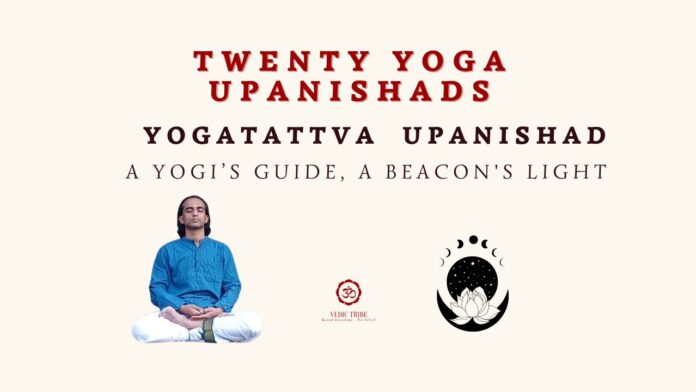A Yogi’s guide, a beacon’s light:
In the previous article, we discussed Brahmavidya Upanishad and in this article, we will discuss – Yogatattva Upanishad.
The Yogatattva Upanishad is a very important text in understanding ancient Yoga schools.
Yoga Darshana: Yoga Darshana, the philosophical foundation of the Yoga school within Vedic thought, centers on Patanjali’s Yoga Sutras, texts that explore the ultimate essence of “Yoga.” These, along with Samkhya and others, are classified as “Darshana Shastras.”
Yoga prakriya: While Darshana texts delve into philosophical contemplation, detailed practical applications of Yoga are not found within them. Instead, these practices, prevalent in ancient times, were later codified during the classical period.
Upanishads like the Yogatattva Upanishad offer valuable insights into these earlier, uncodified Yogic practices, making them essential resources for contemporary practitioners. Yogatattva Upanishad recommends only four sitting postures for pranayama: Siddhasana, Padmasana, Simhasana and Bhadrasana.
Four ancient categories of practical application of Yoga
Yogatattva Upanishad categorizes ancient Yoga-Prakriya into four primary styles:
– Mantra Yoga
– Laya Yoga
– Hatha Yoga
– Raja Yoga
Mantra Yoga
The best example of “mantra yoga” is “Pranava yoga” i.e., meditation upon the beeja-mantra “Om”. The teachings can be found in all twenty Yoga Upanishads.
– Mantra Yoga is a branch of Yoga that utilizes sound vibrations (mantras) as a tool for meditation and spiritual development.
– The core idea is that sound carries specific energies and frequencies that can influence the mind and consciousness.
– By chanting or mentally repeating mantras, practitioners aim to focus the mind, calm mental fluctuations, and connect with higher states of awareness.
– Similarly other beeja-mantras are: Gam (Ganapati), Srim (Lakshmi), Klim (Kali)…etc and meditation upon these are core practice in tantra tradition.
Hence, Mantra Yoga Prakriya has been adopted in both Yoga Tradition and Tantra Tradition.
Laya Yoga
“Laya” literally means “dissolution” or “absorption.”
– In the context of the Upanishads, Laya Yoga signifies the complete dissolution of the mind into the nature of Parabrahman, the ultimate reality.
– It’s not just about sitting in meditation; it’s about integrating this state of absorption into every aspect of life.
– In contemporary popular culture, “Laya Yoga” is often conflated with a modified version of Kundalini Yoga.
– This version typically involves techniques aimed at artificially raising Kundalini energy through the chakras, with the goal of achieving some form of spiritual awakening.
– It must be noted that these practices are not linked to the ancient Laya Yoga practice in any way.
Hatha Yoga
This Upanishad calls “ashtanga yoga” (similar to that of Patanjali’s Yoga Sutra) as “Hatha Yoga”. However, the later Hatha Yoga tradition focuses heavily on postures, regulation of breath, blocking of exits and gestures.
Raja Yoga
The ancient “Raja Yoga” practice focused on “Dhyana” comprising of concentration of mind, focus of mind and dissolution of mind. This ancient Raja Yoga system heavily influenced early Buddhist meditation techniques – specially Theravada school of Buddhism. These meditation techniques are in practice in Myanmar where Theravada Buddhism thrived. Today most of these techniques are incorporated in “Vipassana”.
Key takeaways:
– Study Yogatatva Upanishad and understand its meaning from a scholar and adopt teachings of this Upanishad in your meditative practices.
– If you encounter modern Laya Yoga, question its authority and time tested tradition.
In the next article, we will discuss– “Trishikhibrahmana Upanishad”.
Madhwesh K
Vedic Tribe

